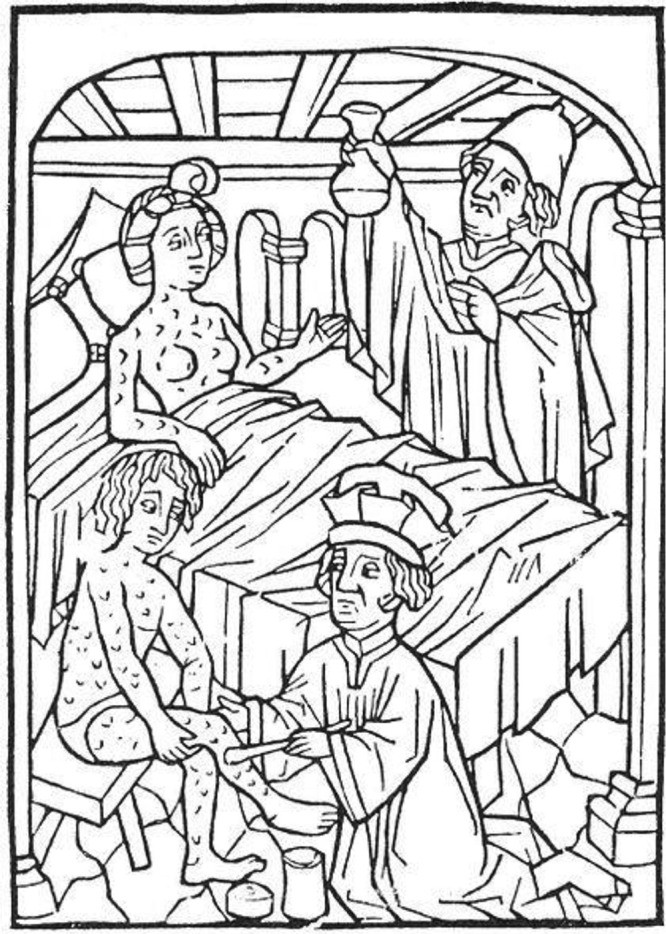Chickenpox, a highly contagious disease, is something most people experience in their childhood. Characterized by an itchy rash with small, fluid-filled blisters, it’s a rite of passage for many. But have you ever stopped to wonder, why is it called chickenpox? The name sounds rather peculiar, especially when considering it has nothing to do with chickens. To understand this quirky moniker, we need to delve into the history of disease nomenclature and the evolution of medical understanding.
The “Pox” in Chickenpox: A Historical Perspective
To begin, let’s dissect the latter part of the name: “pox.” The term “pox” dates back to the late 15th century. In those times, “pox” wasn’t specific to chickenpox; it was a general term used to describe any eruptive disease characterized by sores and pustules. Imagine a time before precise medical diagnoses, where any illness causing skin eruptions might be broadly categorized under the umbrella of “pox.”
During this era, a significant outbreak of syphilis swept through Europe. This severe disease, marked by prominent sores, became known as “the great pox,” or in French, “la grosse verole.” This designation was crucial because it served to differentiate syphilis from another, already recognized disease: smallpox. Smallpox, while also a “pox” disease, was considered less severe in comparison to syphilis, and thus was termed “the small pox,” or “la petite verole.”
The word “pox” itself originates from “pockes,” the plural of “pocke,” akin to “pock.” It essentially described a pustule, blister, or ulcer on the skin, the hallmark of these eruptive diseases. Similar terms existed across languages, like the German “blattern” or “plattern,” and the more general term “pustule,” derived from Old French and Latin roots meaning blister or pimple. These terms paint a picture of how people described and understood skin diseases centuries ago, relying on visible symptoms rather than underlying viral or bacterial causes.
Chickenpox and Smallpox: A History of Confusion
Historically, chickenpox and smallpox were often confused. Both diseases presented with rashes and blisters, leading to considerable overlap in their perceived symptoms by those without modern medical knowledge. It wasn’t until 1767 that a clear distinction was made. William Heberden, an English physician (1710-1801), played a pivotal role in differentiating these two illnesses. His detailed description of chickenpox in his paper “On the Chicken-pox” meticulously outlined the clinical differences between chickenpox and smallpox, establishing them as distinct entities in the medical field.
Even before Heberden’s definitive work, the term “chickenpox” was already in use. Richard Morton (1637-1698), another English physician, used the name chickenpox, characterizing it as a milder form of smallpox. This earlier classification highlights the initial perception of chickenpox as a less dangerous variant of the more feared smallpox, further explaining the need to differentiate them through nomenclature.
Unpacking the “Chicken” in Chickenpox: Theories and Speculations
Now, let’s address the more intriguing part: why “chicken”? Why associate this blistering illness with poultry? There are a few theories attempting to explain this curious prefix.
One popular theory, proposed by British physician Thomas Fuller (1654-1734) in 1730, suggests that the chickenpox lesions resemble pecks or scratches inflicted by “the Bills of chickens.” Imagine the scattered, blister-like rash being likened to marks left by chickens pecking at the skin. This visual analogy, though perhaps a bit whimsical, offers a tangible connection to the name.
Another, perhaps more pragmatic, theory, found in Samuel Johnson’s 1755 dictionary, posits that “chicken” implies mildness or insignificance. In this context, “chickenpox” could mean “mild pox” or “pox of no great danger.” Chicken, often associated with timidity or smallness, might have been used to denote the less severe nature of chickenpox compared to the often deadly smallpox.
While neither theory is definitively proven, they offer plausible explanations rooted in historical context and linguistic interpretations. It’s likely a combination of perceived mildness and the visual appearance of the rash contributed to the adoption and persistence of the name “chickenpox.”
Fig. 1. Syphilis Treatment in the 15th Century
A 15th-century woodcut illustrating the treatment of syphilis, including urine examination and the application of mercury ointment. This image provides a glimpse into early medical practices and the context in which “pox” diseases were understood.
Varicella: The Latin Counterpart
Interestingly, chickenpox also has a Latin name: varicella. The term “varicella” is considered an irregular diminutive of “variola,” the Latin term for smallpox. This Latin name likely emerged in the 18th century, providing a more formal and medically distinct term for chickenpox, while still acknowledging its historical association with smallpox.
Fig. 2. Fernando II de Medici and Smallpox
A portrait of Fernando II de Medici painted in 1626, revealing the full eruption of smallpox rash on the ninth day of his infection. This visual representation underscores the severity of smallpox and the visual similarities that once caused confusion with chickenpox.
Conclusion: The Enduring Enigma of Chickenpox’s Name
So, why is it called chickenpox? The answer isn’t as straightforward as a simple etymological root. It’s a blend of historical context, evolving medical understanding, and perhaps a touch of folk etymology. The “pox” part is clear – it’s a legacy from a time when eruptive skin diseases were grouped together. The “chicken” part remains more speculative, likely stemming from perceived mildness or a visual comparison of the rash.
Despite its somewhat whimsical name, chickenpox is a real and significant disease, caused by the varicella-zoster virus. Understanding the history behind its name offers a fascinating glimpse into how medical terminology evolves and reflects our changing understanding of diseases over centuries. From being confused with the deadly smallpox to being recognized as a distinct, albeit milder, ailment, chickenpox and its name carry a rich history within the broader narrative of infectious diseases.
Fig. 3. Monkeypox Rash: A Modern “Pox”
An image depicting the characteristic rash of monkeypox. The re-emergence of pox viruses like monkeypox reminds us of the historical significance of the “pox” nomenclature and the ongoing relevance of understanding and differentiating these diseases.

